
May - June 2002
Vol. 13, No. 3 | Contents
by Ryan John
Twice as nice … the 2002 Ektelon USRA National Singles Championships, presented by Penn Racquet Sports, will be the 35th playing of the event, and the 20th to be held at the Downtown Houston YMCA
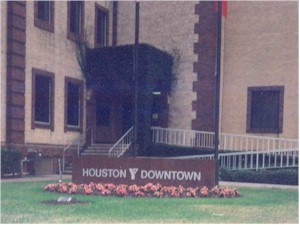 Houston. The name brings many things to mind -
NASA, beautiful skylines, the Astros and the Rockets … even Enron. But for
the die-hard racquetball competitor, the city means only one thing — The
Finals. This year will mark the 20th year running that the USRA has hosted
its flagship national singles event at the Downtown Houston YMCA. And, as
always, it will be celebrated with wonderful parties, great play, and the
annual re-kindling of friendships that originated there.
Houston. The name brings many things to mind -
NASA, beautiful skylines, the Astros and the Rockets … even Enron. But for
the die-hard racquetball competitor, the city means only one thing — The
Finals. This year will mark the 20th year running that the USRA has hosted
its flagship national singles event at the Downtown Houston YMCA. And, as
always, it will be celebrated with wonderful parties, great play, and the
annual re-kindling of friendships that originated there.
In each year since 1983, hundreds of the nation’s best racquetball players have traveled to Houston in search of a championship title. They make the trek not only for the high-level competition, but many look forward to seeing old friends. “I’m like a little social butterfly,” says Malia Bailey, ’83 runner-up to Cindy Baxter in the first National Singles Championships held in Houston. “I like seeing all of the people that I don’t get to see the rest of the year.”
 |
|
1983 in Houston: Baxter & Bailey |
Every year friendships are made and renewed in Houston; many times, it’s the only place far-flung players get to see one another. And as they move up through the age brackets, exchanging wins over the years, rivalries develop along with healthy levels of respect. “You can see that the biggest draws are in the 40’s, 50’s, and 55’s; guys that have been playing for 30 years,” recalls Hall of Famer Ed Remen, who has won several age group national titles. “They can still spit fire on the court then afterwards have a beer together and talk about how good we used to be.”
One of the favorite places for those get-togethers is the lobby bar at the long-time host hotel, the 30-story Hyatt Regency. On registration night the bar is empty. After the first day of play it’s not unusual to find 20 or more players unwinding at happy hour. Throughout the week, the numbers double each evening, up to the post-banquet crowd of nearly everyone on Saturday night.
“Among the advantages (of Houston as the host city) are the facilities available at both the club and the hotel,” explains Jim Hiser, new USRA Executive Director and long-time event director. “The hotel is large enough to accommodate most of the players, so there’s a lot more social interaction away from the actual competition than you see at most tournaments.”
Size is one thing; proximity is another. For players on a budget, there’s no need to rent a car to get from the hotel to the tournament. The hotel and club are only a few blocks apart (with newly-constructed Enron headquarters right in between) and a quick five minute walk will get you there and even give your muscles a chance to warm up a little. Plus the short hike presents another opportunity to mingle, as groups of players hauling gear bags file back and forth from early morning until late at night.
After sundown most player traffic is headed back to the hotel, where nightly social events have replaced standard tournament fare during the day. From the invitation only reception for National Champions on Wednesday, to the grand gala banquet on Saturday, event sponsors and partners have helped to make Houston one of the most anticipated events of the year.
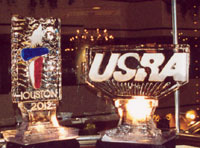 The annual awards banquet is by far the
classiest celebration in racquetball. The USRA male and female athletes
of the year, age group athletes of the year, special
award winners, and Hall
of Fame inductees are all honored on the same night and given an
opportunity to reflect on careers and contributions, while thanking those who
have helped along the way.
The annual awards banquet is by far the
classiest celebration in racquetball. The USRA male and female athletes
of the year, age group athletes of the year, special
award winners, and Hall
of Fame inductees are all honored on the same night and given an
opportunity to reflect on careers and contributions, while thanking those who
have helped along the way.
“The banquet is probably one of the things I look most forward to at this event,” says Hiser. “Watching all of the great players being inducted into the Hall of Fame is always my most memorable part of the tournament.” Hiser has been involved with the National Singles Championships in each of the twenty years that they have been held in Houston.
But competition is still the most important component of this long-running event. “Even though the U.S. OPEN is gaining popularity, Houston is still the number one coveted title,” says Andy Roberts, 1988 U.S. National Singles Champion and 2002 USRA Hall of Fame inductee. “You know that all of the good players are going to be there.”
Not only do all the good players go to Houston to play, but most are able to bring their games up to a new level throughout the tournament. “I usually play 33% better in Houston than I do any other time,” says Remen. “If you can’t step it up at least 25% better than your regular game, you don’t have a chance.”’
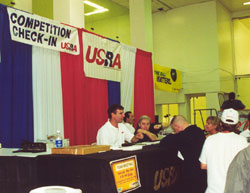 That holds true across the board, as well. It’s
not just the open division players who step up their level of play in search of
an elusive U.S. Team spot. Some of the most memorable matches are played in the
age group divisions. Time and again, when Houston regulars recall their
favorites, stories begin with, “It’s got to be one of the age group matches
I saw.”
That holds true across the board, as well. It’s
not just the open division players who step up their level of play in search of
an elusive U.S. Team spot. Some of the most memorable matches are played in the
age group divisions. Time and again, when Houston regulars recall their
favorites, stories begin with, “It’s got to be one of the age group matches
I saw.”
Roberts admits that he spends a lot of time in Houston watching players compete in divisions such as 60+ and more. “That’s who I tend to watch when I am there,” he says. “I marvel at their competitiveness and their athletic ability at their age.”
“My favorite match,” recalls USRA board member Shelley Ogden, longtime Houston attendee “is when Tom Travers played Johnny Northern.” In that match Travers pulled a thigh muscle in the second game. Down one game to none and hardly able to walk, Travers somehow pulled off the victory and made it to the finals. “He was on one leg and still rolling out the ball,” she continues. “That’s the match that I remember the most.”
Improbable wins and huge comebacks are what makes Houston … well, Houston. “Those are my favorite matches when someone is down and somehow is able to come back,” Malia Bailey agrees.
Still, after two decades in the same venue, the debate about whether or not the national singles should be moved still re-surfaces from time to time. Most of the other major events, with the exception of the U.S. OPEN, relocate on a yearly, or bi-annual, basis. Some feel that it should be moved just to break up the monotony just a bit. “I like Houston fine, but I’d like to see it moved around,” says Remen. “Just to see other places.” And even though he might like to see it moved, even Remen understands it would be difficult to duplicate the tournament environment elsewhere at the same level. “All of the nice clubs I used to play at have closed.”
Hosting over 750 players, and scheduling over 1400 opening round matches takes a lot of square footage, and even though the Houston YMCA has retired a couple of courts over the years, tournament directors still have 16 on which to schedule, full-time, throughout the week. So it’s unlikely that another venue could offer the same tight-knit environment for an event this large. As is, Houston offers a site unique to major tournaments in that it only needs to make use of one club and basically one hotel for the entire event. Logistically, it’s win-win for administrators and players.
Most that we spoke to agreed, and would like to keep the tournament in Houston. “When you talk to somebody about racquetball one of the things you will ask them is, ‘Are you getting ready for Houston? Are you geared up for Houston?’ and everybody knows what you are talking about,” says Bailey.
“There’s a lot to be said for tradition” Hiser concluded “and Houston has plenty of that.” •
Top
The first National Singles was played in 1968; magazines recorded the event at the 10, 20 and 30 year marks ...
| 1977 |
1987 | 1997 |
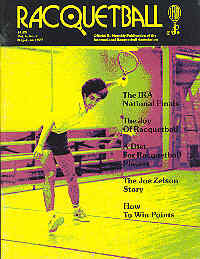 |
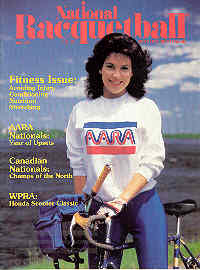 |
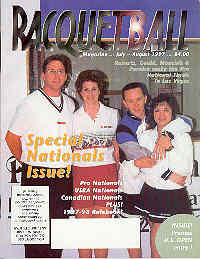 |
Top
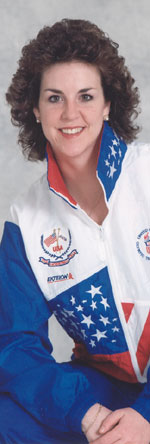 WINNING STREAK
WINNING STREAKAny discussion of Houston and The Finals would be incomplete without mentioning Michelle Gould. Her incredible record stands alone, after she dominated the then-only "major" in the sport for over a decade. Tiger Woods just won the Masters, giving him what the announcers called an unbelievable 6 titles in the last 10 major championships - Gould won 8 U.S. National Singles titles in 10 tries. She even went five years without losing a game, allowing only three opponents to score double-digits. When she finally did lose (to Robin Levine in ‘94) it was dubbed "the upset of the decade" before she returned the next year and proceeded to win three more titles. Her eight titles give her twice as many as any other player.
When asked about how she felt about some of her accomplishments, even Gould was surprised at her stats. "Wow. I didn't know all of that. I was never really much of a statistics person." She went on to say, "It's not really so much the wins or losses, but that you just do your best. That’s all that you can ask of yourself."
Even with the many pressures in Houston, Gould says it was easy to get up for the annual playoff. She also admitted that the most important aspect of The Finals was the chance to earn a spot on the U.S. National Team. "Getting on the National Team was my greatest joy of playing racquetball. I just loved the traveling and competing in different countries and meeting different people."
Gould retired from the sport when she decided to dedicate more time with her husband, Rod, and son, Ryan (2). She says Ryan has already taken to the sport so we may see him on the courts soon. As for Michelle, she only foresees coming back for one reason, "If racquetball gets into the Olympics I would no doubt want to come back." For the moment, that's probably good news to the other women players — at least until racquetball does become an Olympic sport. Then it will just mean that there will be one less team spot available that year. Gould wants to reserve hers now.
Top | RacquetballMagazine.com | USRA.org
© United States Racquetball Association -- All Rights Reserved